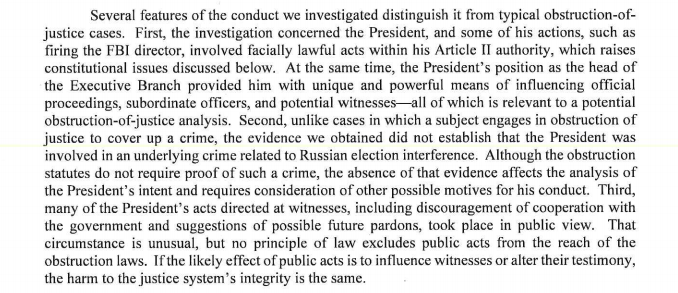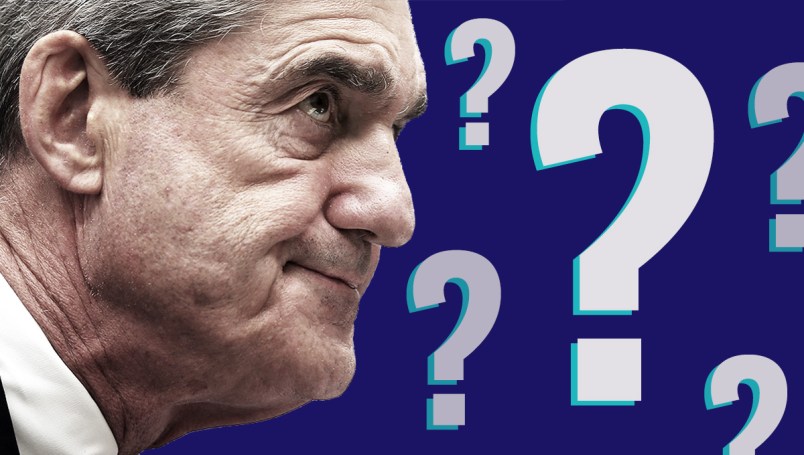Special counsel Robert Mueller’s redacted report released Thursday painted a strikingly different picture for why he did not reach a prosecutorial decision on whether President Trump obstructed justice than the process described by Attorney General Bill Barr.
The discussion comes at the beginning of the second volume of his report, focused on the obstruction aspect of his inquiry. Its executive summary concludes bluntly that had Mueller’s team been able to clear Trump of obstruction based on its investigation, the investigators would have done so. But based on the facts and the legal standards, they could not reach that judgement.

How Mueller got there is complicated. But the summary also suggests Barr mischaracterized how the special counsel approached the obstruction decision. In his first formal description of the obstruction angle of the report, Barr included in Mueller’s own words only the final line of the executive summary’s conclusion — perhaps to acknowledge that Trump was not getting the full exoneration he had been seeking.
But Barr’s description of the report and subsequent reporting implied that Mueller’s team merely threw its hands in the air when it came time to decide to whether Trump had committed an obstruction crime. And thus, the politically thorny task making such a call fell to the attorney general and to his deputy Rod Rosenstein, Barr’s initial letter to Congress about the report seemed to suggest. Barr had claimed that the ultimate decision he and Rosenstein made came regardless of a DOJ opinion prohibiting the indictment of a sitting president.
Mueller was “not saying that but for the OLC opinion, he would have found a crime,” Barr told reporters during a Thursday press conference ahead of the report’s release. “He made it clear that he had not made the determination that there was a crime.”
The redacted report itself, however, provides an entirely different analysis of how Mueller was approaching the obstruction inquiry from a prosecution standpoint and why he didn’t make a prosecution decision.
Crucially, the DOJ internal opinion barring the indictment of a sitting president shaped the very foundations of how Mueller approached the obstruction inquiry, his report’s executive summary makes clear.
It alludes to Congress’ ability to bring impeachment hearings against the President. The summary also emphasized how the DOJ opinion anticipated the possibility that charges could be brought against the President after he left office.
Mueller’s team thus “conducted a thorough factual investigation in order to preserve the evidence when memories were fresh and documentary materials were available.”
Finally, the summary thoroughly rebuts arguments, including those made by Barr himself, that presidential conduct that is authorized by his constitutional powers can be considered criminal.
Altogether, Mueller’s summary undercuts suggestions by Barr that Trump wasn’t charged with obstruction simply because the evidence wasn’t there. Mueller had determined that this was a call he would never be able to make under DOJ guidelines.
The summary begins with a discussion of what “guided” Muller’s obstruction of justice investigation. First it confirms that Mueller worked within the the DOJ opinion, by the Office of Legal Counsel, that disallowed bringing charges against a sitting President. It includes a reference to how bringing charges could preempt “constitutional process for addressing presidential misconduct,” i.e. impeachment.
But with its brief review of the opinion, Mueller, secondly notes that it allows for Presidents to be charged after their terms and that individuals around the President may be charged with obstruction now. Thirdly, Mueller makes clear that he determined not to apply an “approach that could potentially result in a judgement that the President committed crimes,” and discussed this underlying logic, including the interest in fairness.

This interest in fairness was “heightened” in the current situation, Mueller noted, as any internal report on whether the President’s conduct was criminal could become public, comparing it to the OLC opinion’s language barring even a sealed indictment against a sitting President.
This discussion may help answer the major question that has been hanging over the probe since its conclusion: why Mueller himself didn’t say one way or another that Trump’s conduct was criminal.
Everyone from ex-FBI Director Jim Comey to Barr assumed that Mueller would weigh in on this controversial question in his report. In the absence of such a clear statement, Trump crowed about his “complete and total exoneration.”
According to Barr’s initial letter to Congress, because Mueller did not prove that the Trump campaign coordinated with Russia’s 2016 influence campaign, there was no crime to cover up. Mueller addressed this argument as well, as well as Barr’s emphasis in his letter that much of the behavior described took place in public view.
“If the likely effect of the public acts is to influence witnesses or alter their testimony, the harm to the justice system’s integrity is the same,” Mueller said.

Top Democrats and former law enforcement officials questioned why Barr felt empowered to have the final word on obstruction, and whether it would have been better left to Congress. While the President may not have committed a crime in blocking the Mueller probe, his conduct may well have been impeachable, they said.
Barr acknowledged that Mueller never indicated that he should be the deciding voice on obstruction. In mid-April testimony on Capitol Hill, Barr said that this was a “binary” matter of criminal law, and that it made sense for the top Justice Department official to make the decision.
The Attorney General refused to offer further details on his decision-making process until the report came out.







“Mr. Mueller, if this had been any other person, a private citizen perhaps, who engaged in these actions, would you have recommended charging him with obstruction?”
“Yes.”
The End.
ETA: To be fair, he’d probably answer that it would be inappropriate to answer yes or no, but he MUST be asked that question in a public hearing. MUST.
This morning it was “NO COLLUSION!!! NO COLLUSION!!! NO COLLUSION!!! NO COLLUSION!!!”
to this evening’s
“NO COVER-UP!!! NO COVER-UP!!! NO COVER-UP!!! NO COVER-UP!!! NO COVER-UP!!!”
The obstuction was too successful to be proven in court.
Of our elaborate plans
The end
Of everything that stands
The end
No safety or surprise
The end
I’ll never look into your eyes
Again
Can you picture what will be
So limitless and free
Desperately in need of some stranger’s hand
In a desperate land
Lost in a Roman wilderness of pain
And all the children are insane
All the children are insane
Waiting for the summer rain, yeah